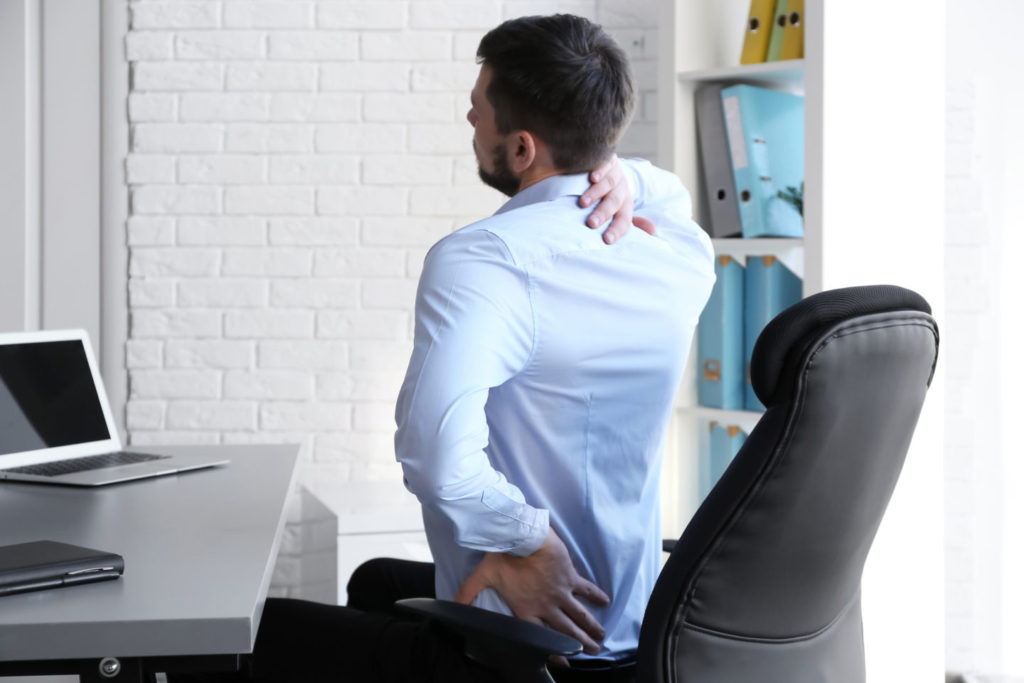How to Prevent Back Pain While Working

It’s hard to focus on your job when your back hurts. Unfortunately, standing or sitting for hours can stress your back and worsen your aches and pains. These six tips can help you reduce or prevent job-related back pain.
1. Change Your Position Often
Stress and strain on your back are more likely to occur when you remain in the same position for a long time. No matter what field you’re in, changing your position regularly will reduce the strain on your back.
Breaks don’t have to be long to be effective. A five-minute standing or stretching break every hour or two will decrease the effects of stress and strain. If you spend most of your shift standing, incorporate a few sitting breaks into your day if possible.
2. Switch to Ergonomic Office Furniture
Ergonomic office furniture reduces stress on your back and improves your sitting posture. Office chairs designed with ergonomic features support the lumbar curve in your lower back and reduce slouching and back strain. Spine-health notes that your chair will be properly adjusted for your height if:
Your arms are even with the top of your desk.
Your feet are flat on the floor. (A small footstool can be helpful if your feet don’t quite reach the floor.)
Your thighs are horizontal.
Ergonomic furniture is just as important whether you work in an office, factory, or at home. Your kitchen chair or couch probably don’t offer adequate support for your back and may contribute to slouching or posture problems.
3. Practice Safe Lifting Techniques
You’re more likely to strain the muscles and ligaments in your back if you don’t use proper lifting techniques or lift an item that’s too heavy for you to safely handle by yourself. When you lift a box or other heavy objects, crouch down and bend your knees. Bending your knees while lifting makes it easier to use your strong leg muscles and limits strain on your back muscles.
Keep the item close to your chest, and don’t twist while you lift. Try picking up a corner of the box before you lift it. If it feels too heavy, ask for help or use machinery to move the item.
4. Wear Supportive Shoes
Your shoes may be a contributing factor in back pain. Your feet support the weight of your body and help keep your spine properly aligned. If your shoes aren’t supportive, you’ll be much more likely to experience back, hip, or leg pain. Wearing shoes with supportive arches or adding orthotics to your shoes can be helpful.
5. Try Stress Reduction Techniques
Stress can cause back pain or make it worse. In fact, 29 percent of Americans surveyed by Statista said that they thought stress was the source of their back pain. When you’re stressed, the muscles in your back, shoulder, and neck become tense, which can lead to pain and headaches.
6. Visit Your Chiropractor!
Visits to your chiropractor will reduce the effects of stress and strain on your back. Back pain often occurs when the vertebrae in your back become misaligned. Misalignments stress joints, muscles, ligaments, and tendons, and can press on nerves causing increased pain. Spinal manipulations, commonly called adjustments, realign the spine, easing pain. Massage, traction, ultrasound therapy, and other chiropractic treatments may also be part of your treatment plan.
Leave a reply


I like that you suggested visiting a chiropractor to prevent the effects of stress and strain on the back which causes the pain that you can experience once there is misalignment. I should suggest the idea to my cousin because he has been experiencing back pain for the past couple of weeks. And I think that it has been caused by him sitting in front of the computer for a long time everyday, and I think that he also slouches.
Reply